check oil NISSAN MAXIMA 2019 Owner´s Manual
[x] Cancel search | Manufacturer: NISSAN, Model Year: 2019, Model line: MAXIMA, Model: NISSAN MAXIMA 2019Pages: 492, PDF Size: 5.82 MB
Page 414 of 492
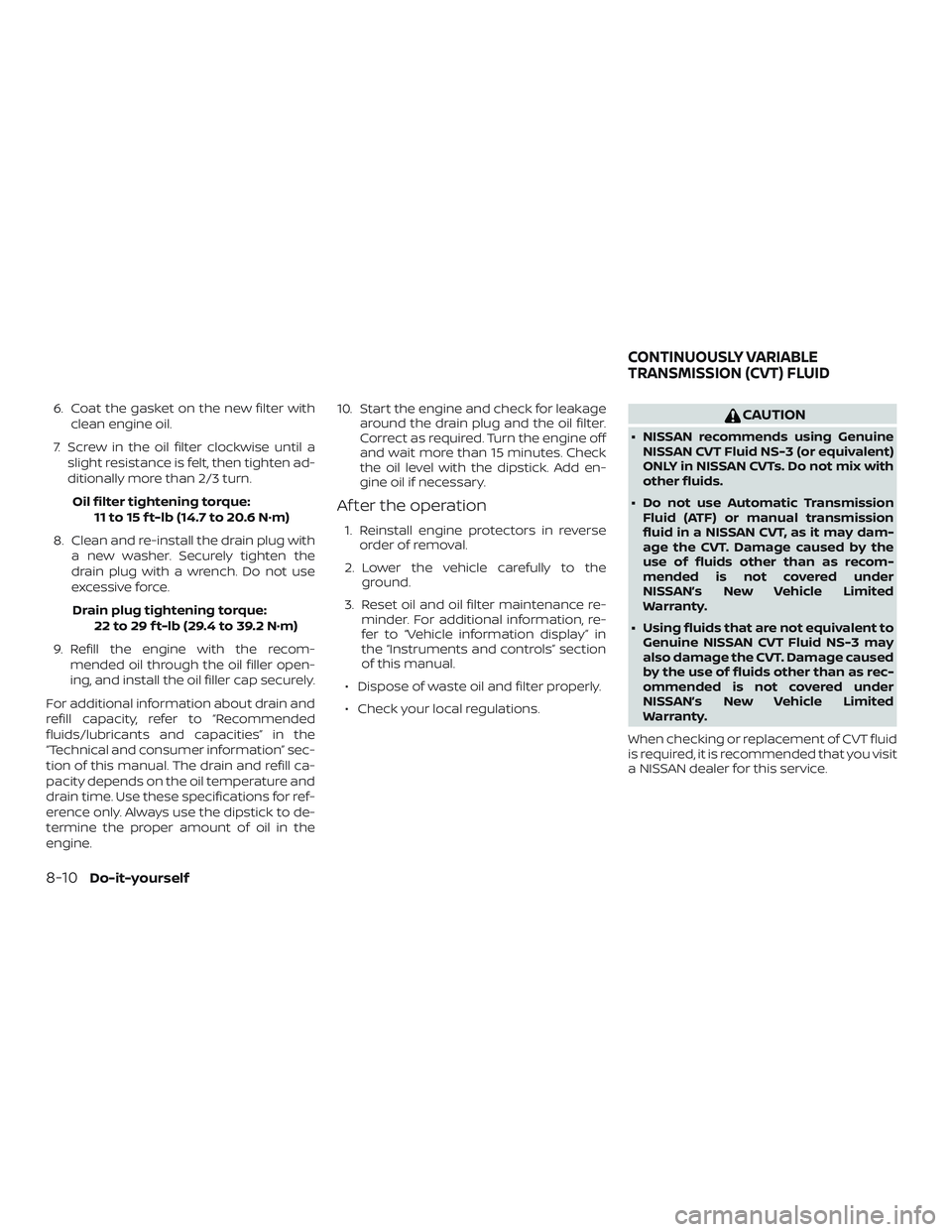
6. Coat the gasket on the new filter withclean engine oil.
7. Screw in the oil filter clockwise until a slight resistance is felt, then tighten ad-
ditionally more than 2/3 turn.
Oil filter tightening torque: 11 to 15 f t-lb (14.7 to 20.6 N·m)
8. Clean and re-install the drain plug with a new washer. Securely tighten the
drain plug with a wrench. Do not use
excessive force.
Drain plug tightening torque: 22 to 29 f t-lb (29.4 to 39.2 N·m)
9. Refill the engine with the recom- mended oil through the oil filler open-
ing, and install the oil filler cap securely.
For additional information about drain and
refill capacity, refer to “Recommended
fluids/lubricants and capacities” in the
“Technical and consumer information” sec-
tion of this manual. The drain and refill ca-
pacity depends on the oil temperature and
drain time. Use these specifications for ref-
erence only. Always use the dipstick to de-
termine the proper amount of oil in the
engine. 10. Start the engine and check for leakage
around the drain plug and the oil filter.
Correct as required. Turn the engine off
and wait more than 15 minutes. Check
the oil level with the dipstick. Add en-
gine oil if necessary.
Af ter the operation
1. Reinstall engine protectors in reverseorder of removal.
2. Lower the vehicle carefully to the ground.
3. Reset oil and oil filter maintenance re- minder. For additional information, re-
fer to “Vehicle information display” in
the “Instruments and controls” section
of this manual.
∙ Dispose of waste oil and filter properly.
∙ Check your local regulations.
CAUTION
∙ NISSAN recommends using Genuine NISSAN CVT Fluid NS-3 (or equivalent)
ONLY in NISSAN CVTs. Do not mix with
other fluids.
∙ Do not use Automatic Transmission Fluid (ATF) or manual transmission
fluid in a NISSAN CVT, as it may dam-
age the CVT. Damage caused by the
use of fluids other than as recom-
mended is not covered under
NISSAN’s New Vehicle Limited
Warranty.
∙ Using fluids that are not equivalent to Genuine NISSAN CVT Fluid NS-3 may
also damage the CVT. Damage caused
by the use of fluids other than as rec-
ommended is not covered under
NISSAN’s New Vehicle Limited
Warranty.
When checking or replacement of CVT fluid
is required, it is recommended that you visit
a NISSAN dealer for this service.
CONTINUOUSLY VARIABLE
TRANSMISSION (CVT) FLUID
8-10Do-it-yourself
Page 428 of 492
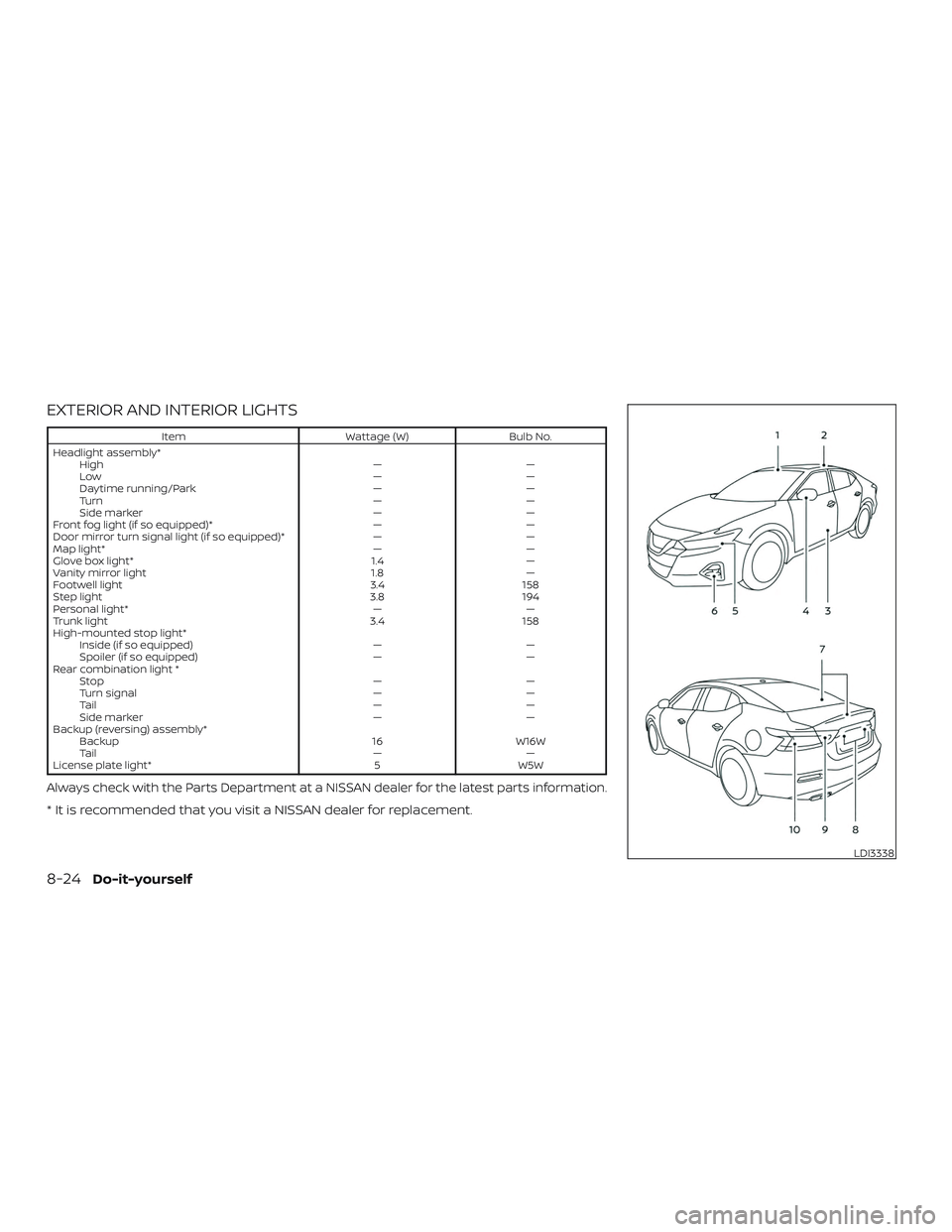
EXTERIOR AND INTERIOR LIGHTS
ItemWattage (W)Bulb No.
Headlight assembly* High ——
Low ——
Daytime running/Park ——
Turn ——
Side marker ——
Front fog light (if so equipped)* ——
Door mirror turn signal light (if so equipped)* ——
Map light* ——
Glove box light* 1.4—
Vanity mirror light 1.8—
Footwell light 3.4158
Step light 3.8194
Personal light* ——
Trunk light 3.4158
High-mounted stop light* Inside (if so equipped) ——
Spoiler (if so equipped) ——
Rear combination light * Stop ——
Turn signal ——
Ta i l ——
Side marker ——
Backup (reversing) assembly* Backup 16W16W
Ta i l ——
License plate light* 5W5W
Always check with the Parts Department at a NISSAN dealer for the latest parts information.
* It is recommended that you visit a NISSAN dealer for replacement.
LDI3338
8-24Do-it-yourself
Page 446 of 492
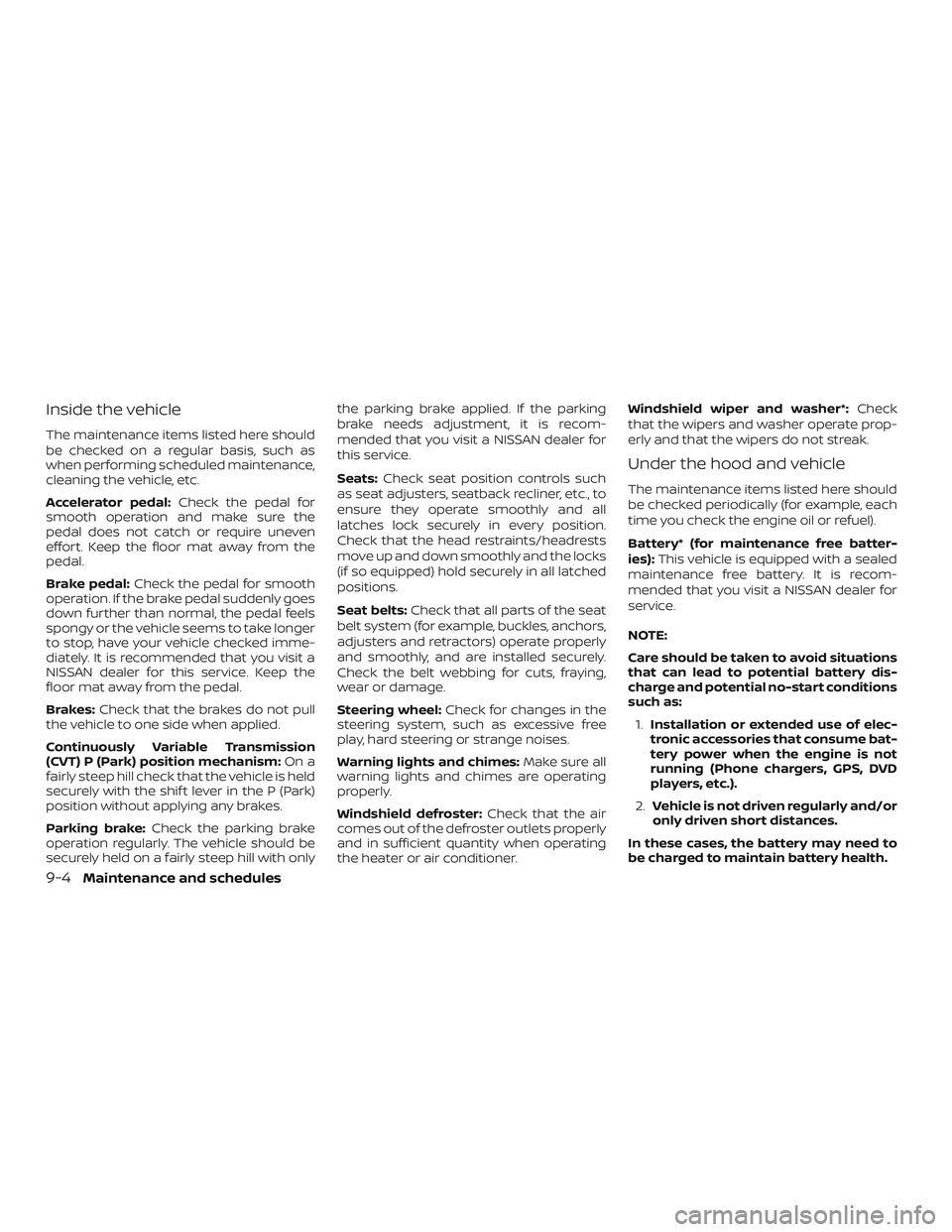
Inside the vehicle
The maintenance items listed here should
be checked on a regular basis, such as
when performing scheduled maintenance,
cleaning the vehicle, etc.
Accelerator pedal:Check the pedal for
smooth operation and make sure the
pedal does not catch or require uneven
effort. Keep the floor mat away from the
pedal.
Brake pedal: Check the pedal for smooth
operation. If the brake pedal suddenly goes
down further than normal, the pedal feels
spongy or the vehicle seems to take longer
to stop, have your vehicle checked imme-
diately. It is recommended that you visit a
NISSAN dealer for this service. Keep the
floor mat away from the pedal.
Brakes: Check that the brakes do not pull
the vehicle to one side when applied.
Continuously Variable Transmission
(CVT) P (Park) position mechanism: On a
fairly steep hill check that the vehicle is held
securely with the shif t lever in the P (Park)
position without applying any brakes.
Parking brake: Check the parking brake
operation regularly. The vehicle should be
securely held on a fairly steep hill with only the parking brake applied. If the parking
brake needs adjustment, it is recom-
mended that you visit a NISSAN dealer for
this service.
Seats:
Check seat position controls such
as seat adjusters, seatback recliner, etc., to
ensure they operate smoothly and all
latches lock securely in every position.
Check that the head restraints/headrests
move up and down smoothly and the locks
(if so equipped) hold securely in all latched
positions.
Seat belts: Check that all parts of the seat
belt system (for example, buckles, anchors,
adjusters and retractors) operate properly
and smoothly, and are installed securely.
Check the belt webbing for cuts, fraying,
wear or damage.
Steering wheel: Check for changes in the
steering system, such as excessive free
play, hard steering or strange noises.
Warning lights and chimes: Make sure all
warning lights and chimes are operating
properly.
Windshield defroster: Check that the air
comes out of the defroster outlets properly
and in sufficient quantity when operating
the heater or air conditioner. Windshield wiper and washer*:
Check
that the wipers and washer operate prop-
erly and that the wipers do not streak.
Under the hood and vehicle
The maintenance items listed here should
be checked periodically (for example, each
time you check the engine oil or refuel).
Battery* (for maintenance free batter-
ies): This vehicle is equipped with a sealed
maintenance free battery. It is recom-
mended that you visit a NISSAN dealer for
service.
NOTE:
Care should be taken to avoid situations
that can lead to potential battery dis-
charge and potential no-start conditions
such as:
1. Installation or extended use of elec-
tronic accessories that consume bat-
tery power when the engine is not
running (Phone chargers, GPS, DVD
players, etc.).
2. Vehicle is not driven regularly and/or
only driven short distances.
In these cases, the battery may need to
be charged to maintain battery health.
9-4Maintenance and schedules
Page 447 of 492
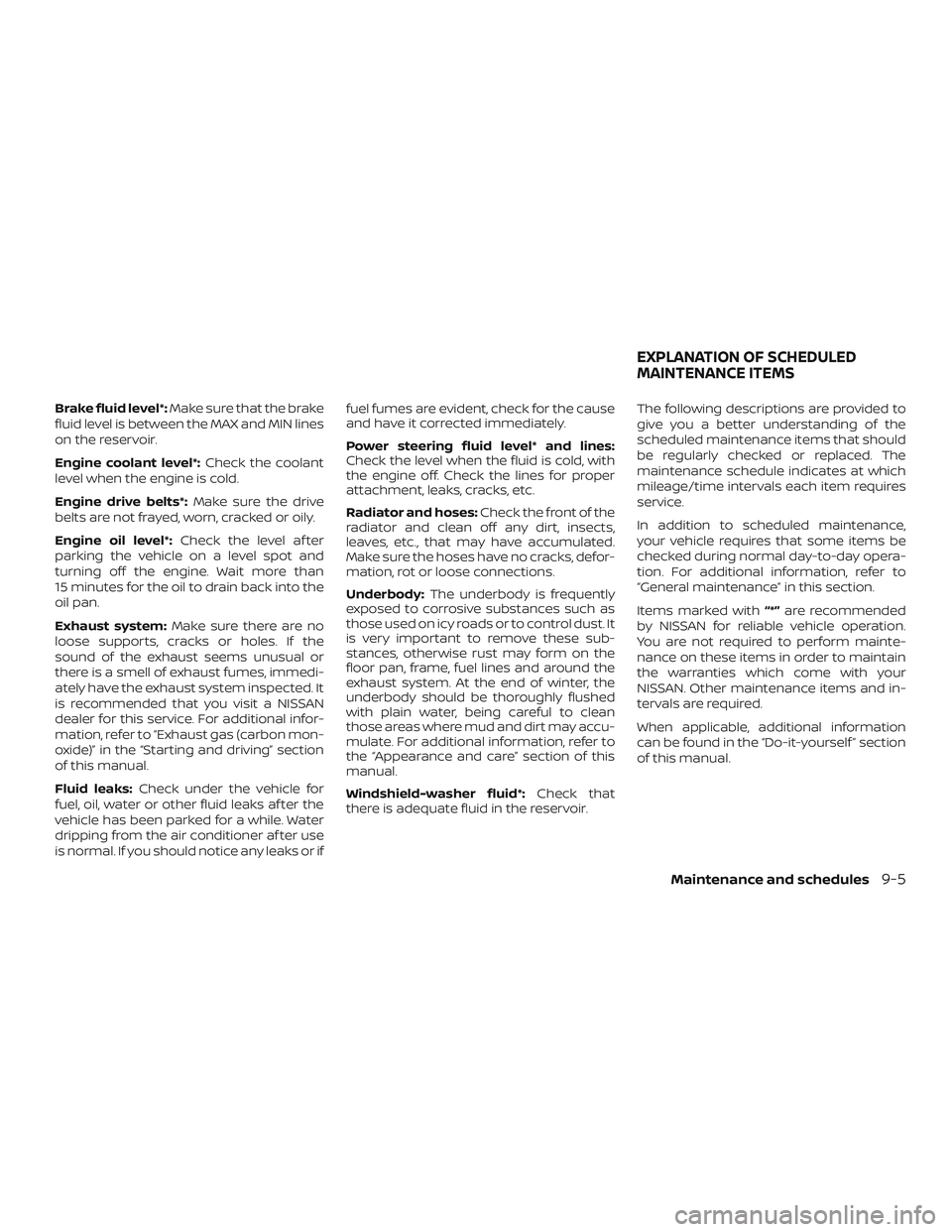
Brake fluid level*:Make sure that the brake
fluid level is between the MAX and MIN lines
on the reservoir.
Engine coolant level*: Check the coolant
level when the engine is cold.
Engine drive belts*: Make sure the drive
belts are not frayed, worn, cracked or oily.
Engine oil level*: Check the level af ter
parking the vehicle on a level spot and
turning off the engine. Wait more than
15 minutes for the oil to drain back into the
oil pan.
Exhaust system: Make sure there are no
loose supports, cracks or holes. If the
sound of the exhaust seems unusual or
there is a smell of exhaust fumes, immedi-
ately have the exhaust system inspected. It
is recommended that you visit a NISSAN
dealer for this service. For additional infor-
mation, refer to “Exhaust gas (carbon mon-
oxide)” in the “Starting and driving” section
of this manual.
Fluid leaks: Check under the vehicle for
fuel, oil, water or other fluid leaks af ter the
vehicle has been parked for a while. Water
dripping from the air conditioner af ter use
is normal. If you should notice any leaks or if fuel fumes are evident, check for the cause
and have it corrected immediately.
Power steering fluid level* and lines:
Check the level when the fluid is cold, with
the engine off. Check the lines for proper
attachment, leaks, cracks, etc.
Radiator and hoses:
Check the front of the
radiator and clean off any dirt, insects,
leaves, etc., that may have accumulated.
Make sure the hoses have no cracks, defor-
mation, rot or loose connections.
Underbody: The underbody is frequently
exposed to corrosive substances such as
those used on icy roads or to control dust. It
is very important to remove these sub-
stances, otherwise rust may form on the
floor pan, frame, fuel lines and around the
exhaust system. At the end of winter, the
underbody should be thoroughly flushed
with plain water, being careful to clean
those areas where mud and dirt may accu-
mulate. For additional information, refer to
the “Appearance and care” section of this
manual.
Windshield-washer fluid*: Check that
there is adequate fluid in the reservoir. The following descriptions are provided to
give you a better understanding of the
scheduled maintenance items that should
be regularly checked or replaced. The
maintenance schedule indicates at which
mileage/time intervals each item requires
service.
In addition to scheduled maintenance,
your vehicle requires that some items be
checked during normal day-to-day opera-
tion. For additional information, refer to
“General maintenance” in this section.
Items marked with
“*”are recommended
by NISSAN for reliable vehicle operation.
You are not required to perform mainte-
nance on these items in order to maintain
the warranties which come with your
NISSAN. Other maintenance items and in-
tervals are required.
When applicable, additional information
can be found in the “Do-it-yourself ” section
of this manual.
EXPLANATION OF SCHEDULED
MAINTENANCE ITEMS
Maintenance and schedules9-5
Page 448 of 492
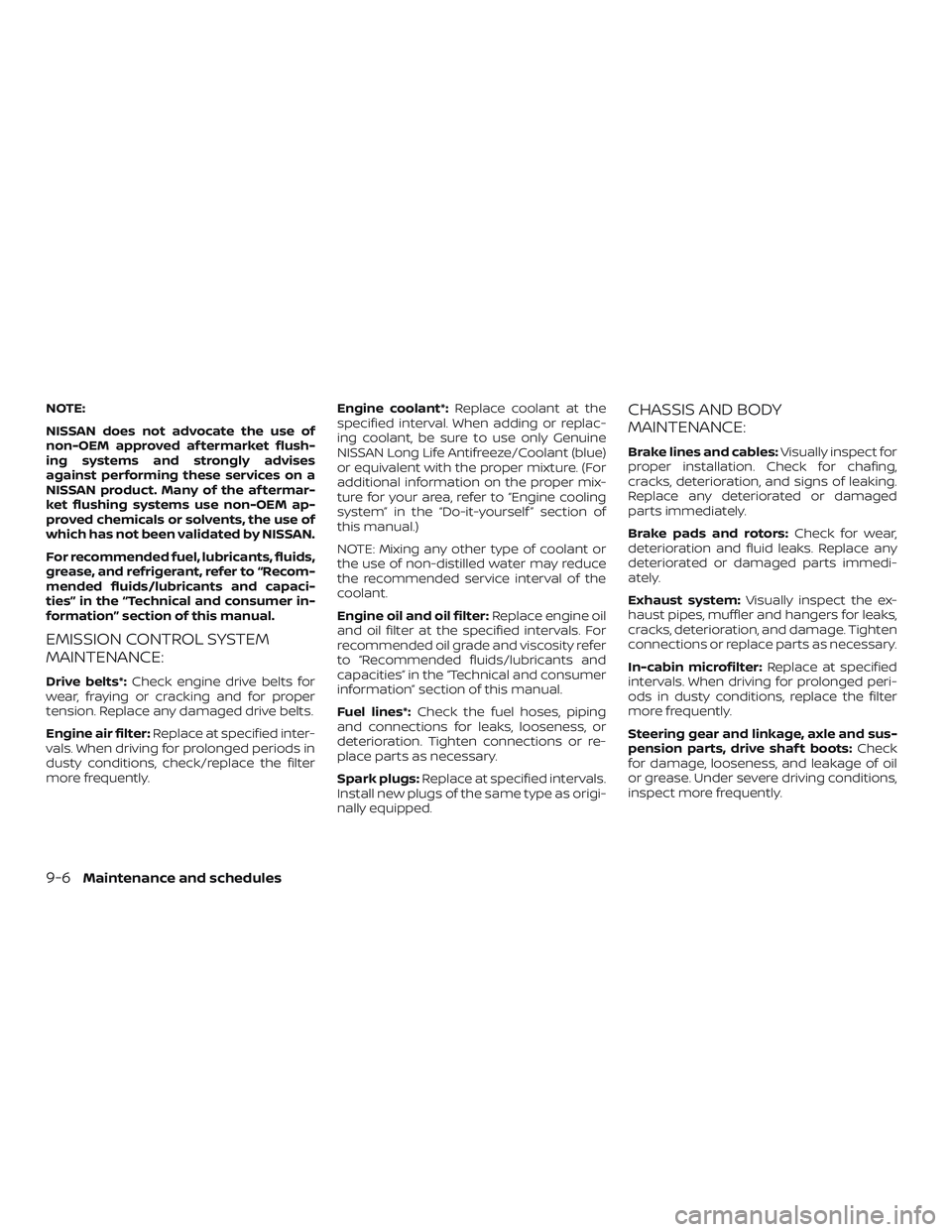
NOTE:
NISSAN does not advocate the use of
non-OEM approved af termarket flush-
ing systems and strongly advises
against performing these services on a
NISSAN product. Many of the af termar-
ket flushing systems use non-OEM ap-
proved chemicals or solvents, the use of
which has not been validated by NISSAN.
For recommended fuel, lubricants, fluids,
grease, and refrigerant, refer to “Recom-
mended fluids/lubricants and capaci-
ties” in the “Technical and consumer in-
formation” section of this manual.
EMISSION CONTROL SYSTEM
MAINTENANCE:
Drive belts*:Check engine drive belts for
wear, fraying or cracking and for proper
tension. Replace any damaged drive belts.
Engine air filter: Replace at specified inter-
vals. When driving for prolonged periods in
dusty conditions, check/replace the filter
more frequently. Engine coolant*:
Replace coolant at the
specified interval. When adding or replac-
ing coolant, be sure to use only Genuine
NISSAN Long Life Antifreeze/Coolant (blue)
or equivalent with the proper mixture. (For
additional information on the proper mix-
ture for your area, refer to “Engine cooling
system” in the “Do-it-yourself ” section of
this manual.)
NOTE: Mixing any other type of coolant or
the use of non-distilled water may reduce
the recommended service interval of the
coolant.
Engine oil and oil filter: Replace engine oil
and oil filter at the specified intervals. For
recommended oil grade and viscosity refer
to “Recommended fluids/lubricants and
capacities” in the “Technical and consumer
information” section of this manual.
Fuel lines*: Check the fuel hoses, piping
and connections for leaks, looseness, or
deterioration. Tighten connections or re-
place parts as necessary.
Spark plugs: Replace at specified intervals.
Install new plugs of the same type as origi-
nally equipped.
CHASSIS AND BODY
MAINTENANCE:
Brake lines and cables: Visually inspect for
proper installation. Check for chafing,
cracks, deterioration, and signs of leaking.
Replace any deteriorated or damaged
parts immediately.
Brake pads and rotors: Check for wear,
deterioration and fluid leaks. Replace any
deteriorated or damaged parts immedi-
ately.
Exhaust system: Visually inspect the ex-
haust pipes, muffler and hangers for leaks,
cracks, deterioration, and damage. Tighten
connections or replace parts as necessary.
In-cabin microfilter: Replace at specified
intervals. When driving for prolonged peri-
ods in dusty conditions, replace the filter
more frequently.
Steering gear and linkage, axle and sus-
pension parts, drive shaf t boots: Check
for damage, looseness, and leakage of oil
or grease. Under severe driving conditions,
inspect more frequently.
9-6Maintenance and schedules
Page 449 of 492
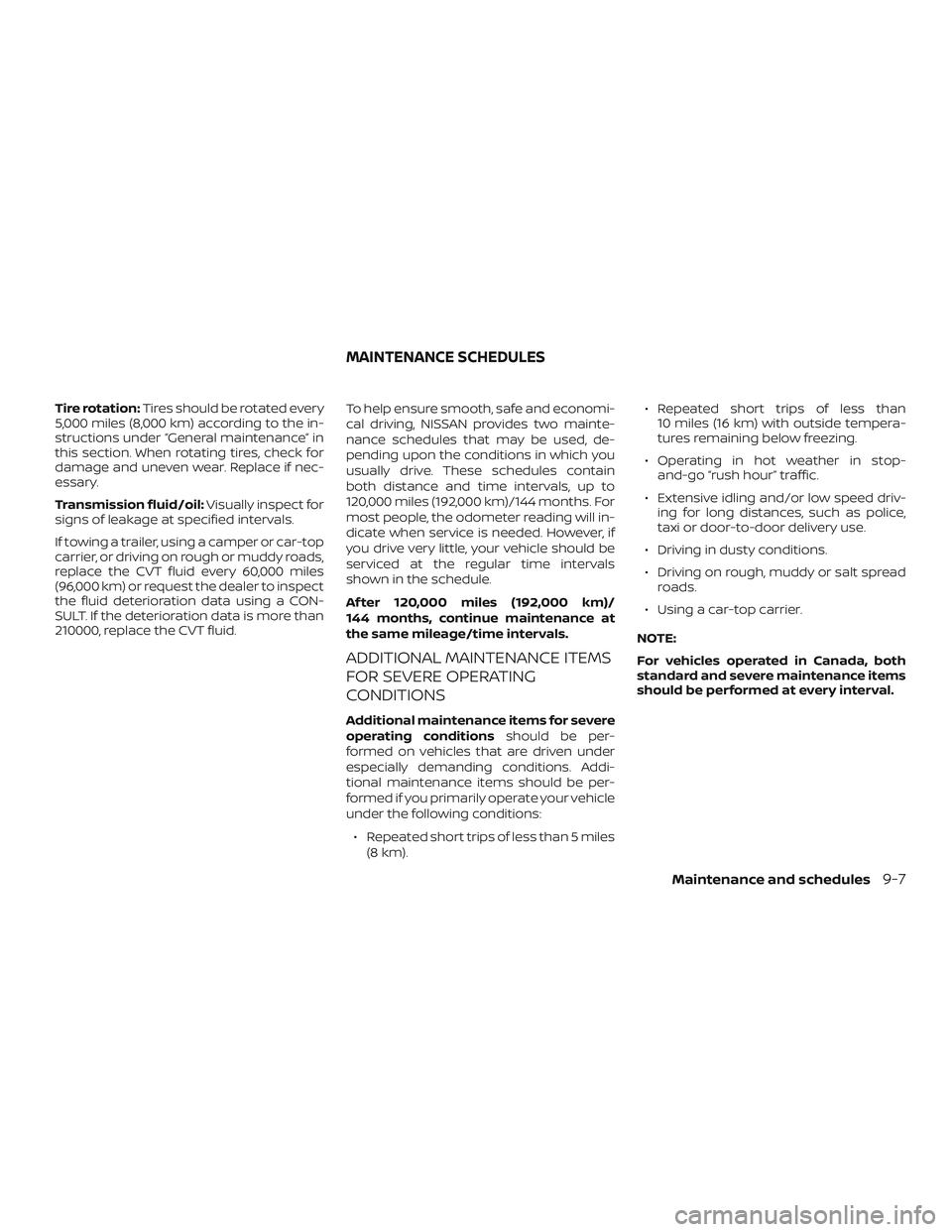
Tire rotation:Tires should be rotated every
5,000 miles (8,000 km) according to the in-
structions under “General maintenance” in
this section. When rotating tires, check for
damage and uneven wear. Replace if nec-
essary.
Transmission fluid/oil: Visually inspect for
signs of leakage at specified intervals.
If towing a trailer, using a camper or car-top
carrier, or driving on rough or muddy roads,
replace the CVT fluid every 60,000 miles
(96,000 km) or request the dealer to inspect
the fluid deterioration data using a CON-
SULT. If the deterioration data is more than
210000, replace the CVT fluid. To help ensure smooth, safe and economi-
cal driving, NISSAN provides two mainte-
nance schedules that may be used, de-
pending upon the conditions in which you
usually drive. These schedules contain
both distance and time intervals, up to
120,000 miles (192,000 km)/144 months. For
most people, the odometer reading will in-
dicate when service is needed. However, if
you drive very little, your vehicle should be
serviced at the regular time intervals
shown in the schedule.
Af ter 120,000 miles (192,000 km)/
144 months, continue maintenance at
the same mileage/time intervals.
ADDITIONAL MAINTENANCE ITEMS
FOR SEVERE OPERATING
CONDITIONS
Additional maintenance items for severe
operating conditions
should be per-
formed on vehicles that are driven under
especially demanding conditions. Addi-
tional maintenance items should be per-
formed if you primarily operate your vehicle
under the following conditions:
∙ Repeated short trips of less than 5 miles (8 km). ∙ Repeated short trips of less than
10 miles (16 km) with outside tempera-
tures remaining below freezing.
∙ Operating in hot weather in stop- and-go “rush hour” traffic.
∙ Extensive idling and/or low speed driv- ing for long distances, such as police,
taxi or door-to-door delivery use.
∙ Driving in dusty conditions.
∙ Driving on rough, muddy or salt spread roads.
∙ Using a car-top carrier.
NOTE:
For vehicles operated in Canada, both
standard and severe maintenance items
should be performed at every interval.
MAINTENANCE SCHEDULES
Maintenance and schedules9-7
Page 479 of 492
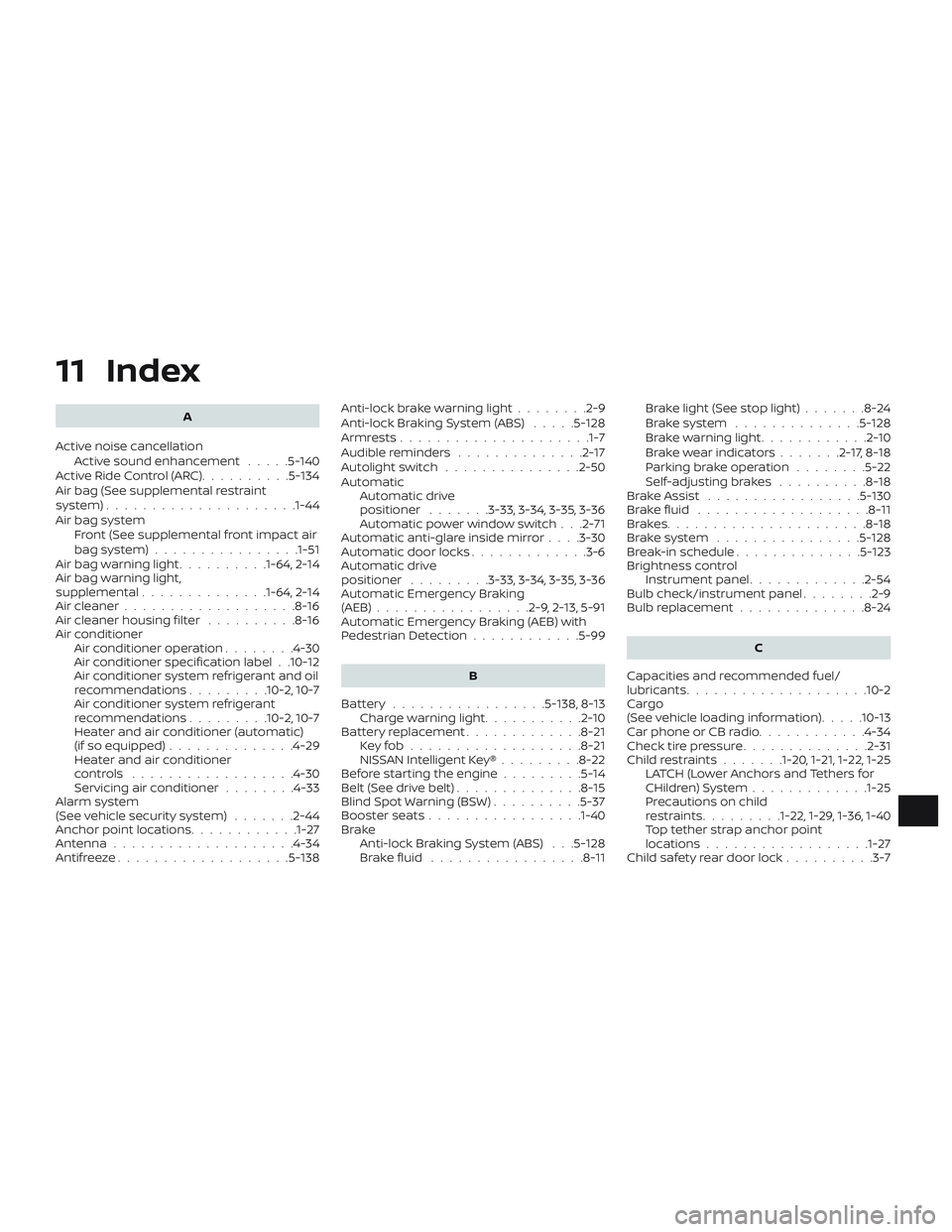
11 Index
A
Active noise cancellation Active sound enhancement .....5-140
ActiveRideControl(ARC)..........5-134
Air bag (See supplemental restraint
system) .................... .1-44
Air bag system Front (See supplemental front impact air
bagsystem)................1-51
Airbagwarninglight..........1-64, 2-14
Air bag warning light,
supplemental ..............1-64, 2-14
Air cleaner ...................8-16
Air cleaner housing filter ..........8-16
Air conditioner Air conditioner operation ........4-30
Air conditioner specification label . .10-12
Air conditioner system refrigerant and oil
recommendations .........10-2,10-7
Air conditioner system refrigerant
recommendations .........10-2,10-7
Heater and air conditioner (automatic)
(if so equipped) ..............4-29
Heater and air conditioner
controls ..................4-30
Servicing air conditioner ........4-33
Alarm system
(See vehicle security system) .......2-44
Anchor point locations ............1-27
Antenna ....................4-34
Antifreeze ...................5-138 Anti-lock brake warning light
........2-9
Anti-lock Braking System (ABS) .....5-128
Armrests.................... .1-7
Audible reminders ..............2-17
Autolightswitch ...............2-50
Automatic Automatic drive
positioner .......3-33, 3-34, 3-35, 3-36
Automatic power window switch . . .2-71
Automatic anti-glare inside mirror ....3-30
Automatic door locks .............3-6
Automatic drive
positioner .........3-33,3-34,3-35,3-36
Automatic Emergency Braking
(AEB) .................2-9,2-13,5-91
Automatic Emergency Braking (AEB) with
Pedestrian Detection ............5-99
B
Battery .................5-138,8-13 Charge warning light ...........2-10
Battery replacement .............8-21
Keyfob...................8-21
NISSAN Intelligent Key® .........8-22
Before starting the engine .........5-14
Belt(Seedrivebelt)..............8-15
Blind Spot Warning (BSW) ..........5-37
Booster seats .................1-40
Brake Anti-lock Braking System (ABS) . . .5-128
Brakefluid .................8-11 Brakelight(Seestoplight).......8-24
Brakesystem ..............5-128
Brakewarninglight............2-10
Brakewearindicators.......2-17,8-18
Parking brake operation
........5-22
Self-adjustingbrakes ..........8-18
Brake Assist .................5-130
Brakefluid ...................8-11
Brakes......................8-18
Brakesystem ................5 -128
Break-in schedule ..............5-123
Brightness control Instrument panel .............2-54
Bulb check/instrument panel ........2-9
Bulb replacement ..............8-24
C
Capacities and recommended fuel/
lubricants....................10-2
Cargo
(See vehicle loading information) .....10-13
Car phone or CB radio ............
4
-34
Check tire pressure ..............2-31
Childrestraints.......1-20, 1-21, 1-22, 1-25 LATCH (Lower Anchors and Tethers for
CHildren)System.............1-25
Precautions on child
restraints.........1-22, 1-29, 1-36, 1-40
Top tether strap anchor point
locations................. .1-27
Child safety rear door lock ..........3-7
Page 480 of 492
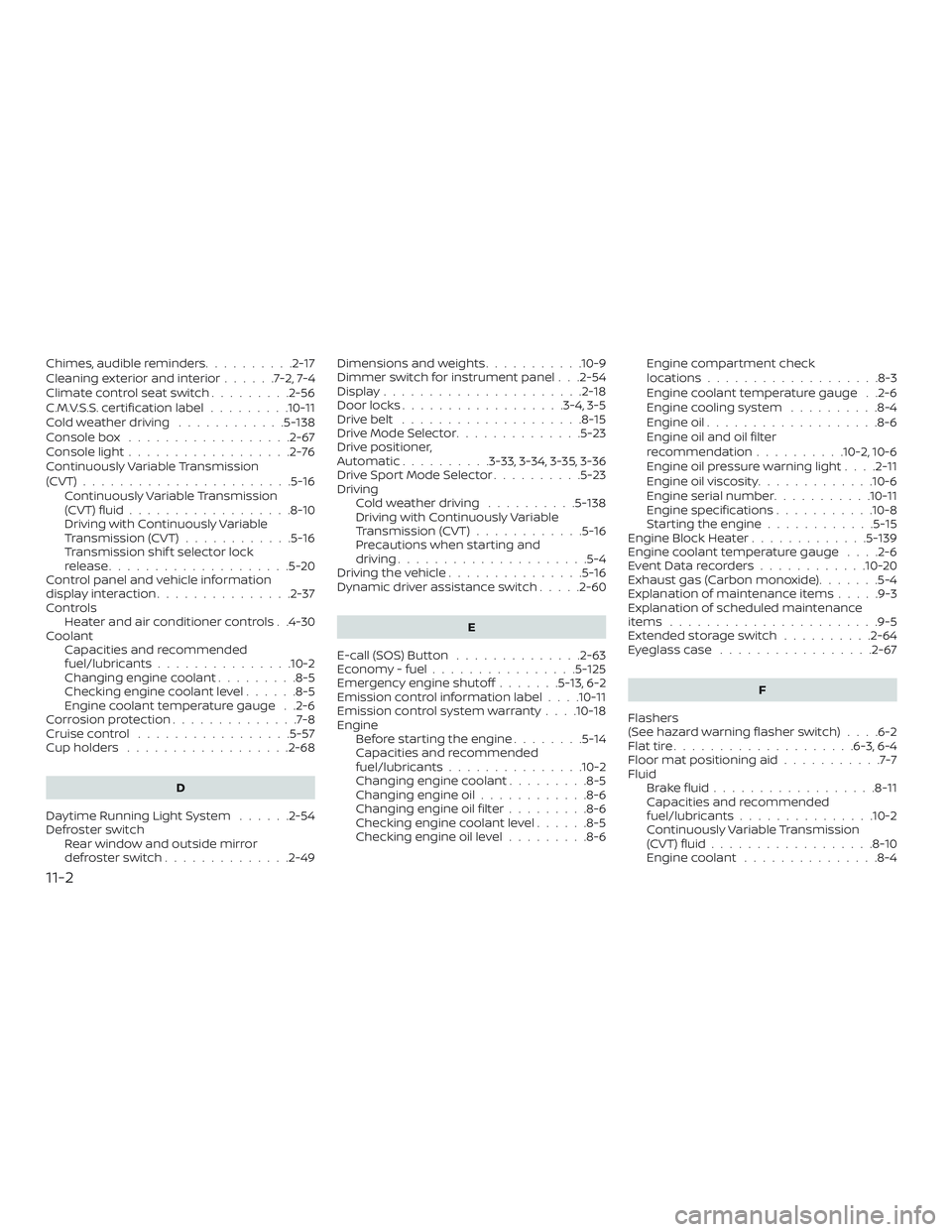
Chimes, audible reminders..........2-17
Cleaningexteriorandinterior......7-2,7-4
Climatecontrolseatswitch.........2-56
C.M.V.S.S. certification label .........10-11
Coldweatherdriving ............5-138
Console box ..................2-67
Console light ..................2-76
Continuously Variable Transmission
(CVT) .......................5-16
Continuously Variable Transmission
(CVT) fluid ..................8-10
Driving with Continuously Variable
Transmission (CVT) ............5-16
Transmission shif t selector lock
release....................5-20
Control panel and vehicle information
displayinteraction...............2-37
Controls Heater and air conditioner controls . .4-30
Coolant Capacities and recommended
fuel/lubricants...............10-2
Changing engine coolant .........8-5
Checking engine coolant level ......8-5
Engine coolant temperature gauge . .2-6
Corrosionprotection..............7-8
Cruisecontrol .................5-57
Cupholders ..................2-68
D
Daytime Running Light System ......2-54
Defroster switch Rear window and outside mirror
defrosterswitch..............2-49 Dimensions and weights
...........10-9
Dimmer switch for instrument panel . . .2-54
Display......................2-18
Door locks ..................3-4,3-5
Drivebelt ....................8-15
Drive Mode Selector ..............5-23
Drive positioner,
Automatic..........3-33, 3-34, 3-35, 3-36
Drive Sport Mode Selector ..........5-23
Driving Cold weather driving ..........5-138
Driving with Continuously Variable
Transmission (CVT) ............5-16
Precautions when starting and
driving.....................5-4
Drivingthevehicle...............5-16
Dynamic driver assistance switch .....2-60
E
E-call (SOS) Button ..............2-63
Economy - fuel ................5-125
Emergency engine shutoff .......5-13,6-2
Emission control information label . . . .10-11
Emission control system warranty . . . .10-18
Engine Before starting the engine ........5-14
Capacities and recommended
fuel/lubricants...............10-2
Changing engine coolant .........8-5
Changing engine oil ............8-6
Changing engine oil filter .........8-6
Checking engine coolant level ......8-5
Checking engine oil level .........8-6Engine compartment check
locations...................8-3
Engine coolant temperature gauge . .2-6
Engine cooling system
..........8-4
Engine oil ...................8-6
Engine oil and oil filter
recommendation ..........10-2,10-6
Engine oil pressure warning light ....2-11
Engine oil viscosity .............10-6
Engine serial number ...........10-11
Engine specifications ...........10-8
Starting the engine ............5-15
Engine Block Heater .............5-139
Engine coolant temperature gauge ....2-6
EventDatarecorders............10-20
Exhaust gas (Carbon monoxide) .......5-4
Explanation of maintenance items .....9-3
Explanation of scheduled maintenance
items .......................9-5
Extended storage switch ..........2-64
Eyeglasscase .................2-67
F
Flashers
(Seehazardwarningflasherswitch)....6-2
F l
attire....................6-3,6-4
Floormatpositioningaid...........7-7
Fluid Brakefluid..................8-11
Capacities and recommended
fuel/lubricants...............10-2
Continuously Variable Transmission
(CVT) fluid ..................8-10
Engine coolant ...............8-4
11-2
Page 483 of 492
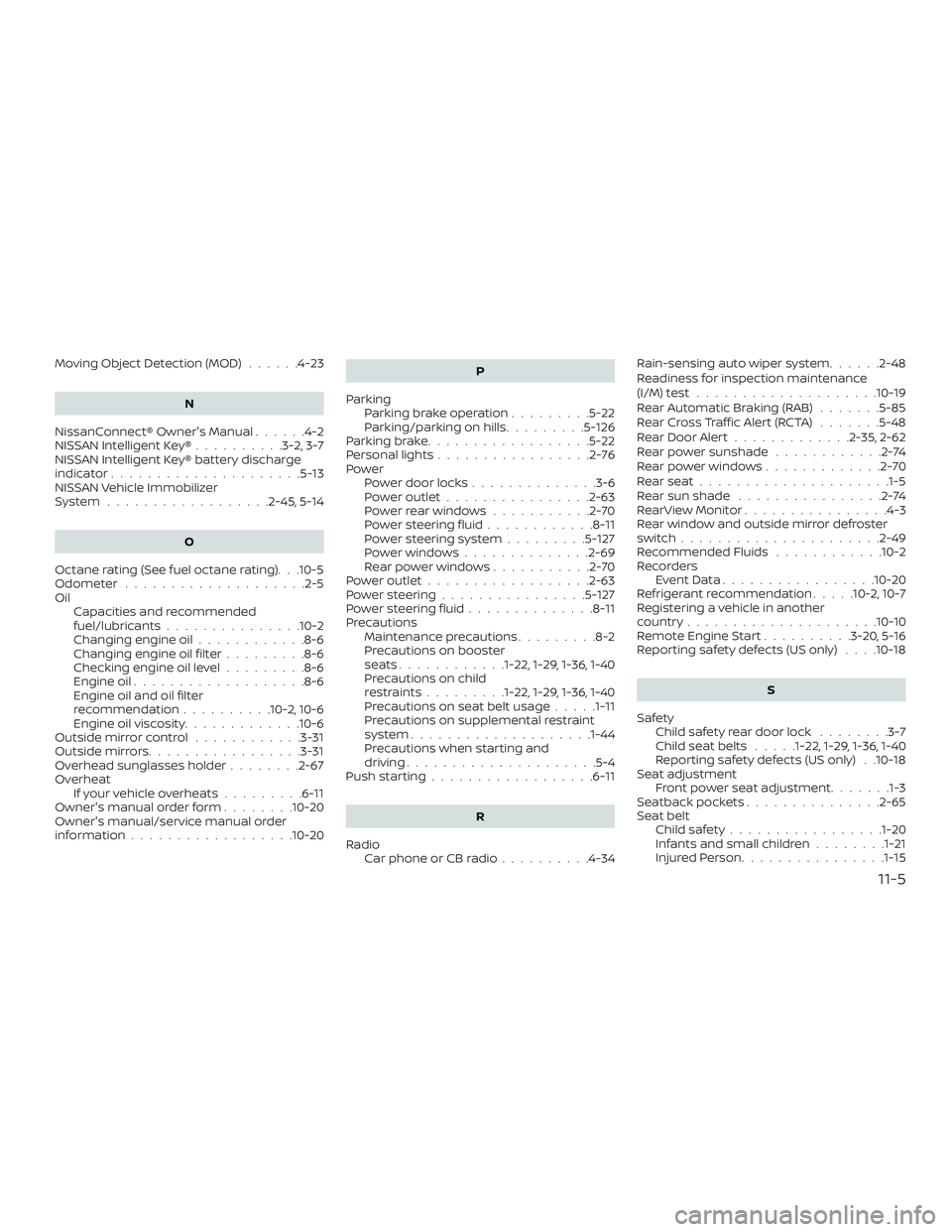
Moving Object Detection (MOD)......4-23
N
NissanConnect® Owner's Manual ......4-2
NISSAN Intelligent Key® ..........3-2,3-7
NISSAN Intelligent Key® battery discharge
indicator.....................5-13
NISSAN Vehicle Immobilizer
System ..................2-45,5-14
O
Octane rating (See fuel octane rating). . .10-5
Odometer ....................2-5
Oil Capacities and recommended
fuel/lubricants...............10-2
Changing engine oil ............8-6
Changing engine oil filter .........8-6
Checking engine oil level .........8-6
Engine oil ...................8-6
Engine oil and oil filter
recommendation ..........10-2,10-6
Engine oil viscosity .............10-6
Outsidemirrorcontrol ............3-31
Outsidemirrors.................3-31
Overhead sunglasses holder ........2-67
Overheat Ifyourvehicleoverheats.........6-11
Owner's manual order form ........10-20
Owner's manual/service manual order
information..................10-20 P
Parking Parking brake operation .........5-22
Parking/parkingonhills.........5-126
Parkingbrake..................5-22
Personal lights .................2-76
Power Power door locks ..............3-6
Poweroutlet................2-63
Powerrearwindows...........2-70
Powersteeringfluid............8-11
Power steering system .........5-127
Powerwindows..............2-69
Rearpowerwindows...........2-70
Poweroutlet..................2-63
Powersteering................5-127
Powersteeringfluid..............8-11
Precautions Maintenance precautions .........8-2
Precautions on booster
seats............1-22, 1-29, 1-36, 1-40
Precautions on child
restraints.........1-22, 1-29, 1-36, 1-40
Precautions on seat belt usage .....1-11
Precautions on supplemental restraint
system ....................1-44
Precautions when starting and
driving.....................5-4
Push starting ..................6-11
R
Radio Car phone or CB radio ..........4-34Rain-sensingautowipersystem......2-48
Readiness for inspection maintenance
(I/M) test
....................10-19
Rear Automatic Braking (RAB) .......5-85
RearCrossTrafficAlert(RCTA) .......5-48
Rear Door Alert .............2-35, 2-62
Rear power sunshade ............2-74
Rearpowerwindows............ .2-70
Rearseat.....................1-5
Rear sun shade ................2-74
RearViewMonitor................4-3
Rear window and outside mirror defroster
switch......................2-49
Recommended Fluids ............10-2
Recorders EventData.................10-20
Refrigerant recommendation .....10-2,10-7
Registering a vehicle in another
country .....................10-10
Remote Engine Start ..........3-20,5-16
Reporting safety defects (US only) . . . .10-18
S
Safety Child safety rear door lock ........3-7
C h
ildseatbelts .....1-22, 1-29, 1-36, 1-40
Reporting safety defects (US only) . .10-18
Seat adjustment Front power seat adjustment .......1-3
Seatback pockets ...............2-65
Seat belt Childsafety.................1-20
Infants and small children ........1-21
InjuredPerson............... .1-15
11-5